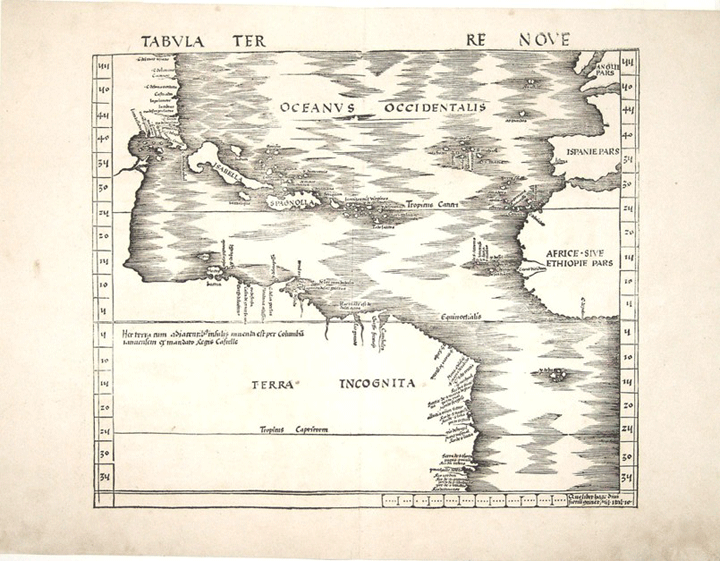A Perspective on Maps and their Place in the Heavens
- by Bruce E. McKinney

The 1513 Tabula Terre Nove by Waldseemuller [offered by Martayan Lan]
By Bruce McKinney
The April Comet
When people think about books and look online they seem at first glance to be a single universe. Fiction and non-fiction exist side by side as do books just published and those printed five hundred years ago. Illustrated books, childrens books, illustrated material, autobiography, books on ants and others on elephants are all one click away. This is because online listing sites tend to arrange material alphabetically by author or title and sort it in ascending or descending price order. The difference between an original printing and a reproduction of the Gutenberg Bible therefore will be price and the distinctions sorted out by the listing-reader. These differences are of course extraordinary but for many, perhaps even most, works on paper these variations are less apparent and therefore more difficult to understand. Such difficult to understand but important distinctions coupled with the public's collecting interest, are the principal drivers for the development of specialist dealers, the polar opposite of the generalist bookseller upon which the book business has been built. The generalist can be said to know the distance from Palm Beach to London, the specialist the depth and temperature of the water. In the map field, a narrow category and the subject of this month's Comet, there is plenty of room for both perspectives because while there are always collectors seeking the Everests there are more that climb the Shawangunks, the Catskills and the Piedmonts and feel well-compensated if they find an item of personal interest. The very existance of AE is evidence of this broad based interest for here, while we are focused on rare and collectible works on paper, we understand the fun is unearthing the right item whether it is $40 or $40,000.
Within the world of collectible works on paper one of the strongest and perhaps even the strongest segment is cartography [it's a map if its says Esso, cartography if it costs more than $1,000]. This field manages to win the trifecta because it's often interesting and attractive to both the collector and their spouse for whom the collection is history and attractive presentation. A library of course will do this too but libraries do not announce themselves so well as maps [and images for that matter] that can tell their story when framed and mounted on walls. Maps also gain from the multiple communities that offer them. Some maps are independent productions but many others begin life as an image in an atlas or book and hence are bought and sold in the world of books. Even as recently as the 1950's Howes' Usiana accorded little additional value to books with maps. Content, maps and images had parity. Today maps live on the other side of the rainbow, a pricing trend that Graham Arader, the exceptional map dealer, recently explained this way:
"Map prices have increased at a 400% rate per decade over the past 40 years. With Smiley [the Edward Scissorhands of library map plundering now in jail], others out of the picture and map librarians more diligent and protective, the artificial liquidity in exceptional maps evident the past 10 years, is passing and prices are rising. Looking ahead I expect as much as a 30 fold increase over the next 10 years in the value of important maps as scarcity increases. Even pedestrian material will do well. Images are in their moment."